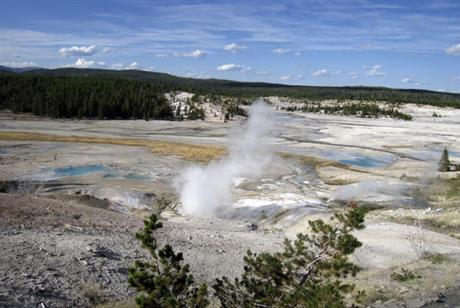- California Assembly OKs highest minimum wage in nation
- S. Korea unveils first graphic cigarette warnings
- US joins with South Korea, Japan in bid to deter North Korea
- LPGA golfer Chun In-gee finally back in action
- S. Korea won’t be top seed in final World Cup qualification round
- US men’s soccer misses 2nd straight Olympics
- US back on track in qualifying with 4-0 win over Guatemala
- High-intensity workout injuries spawn cottage industry
- CDC expands range of Zika mosquitoes into parts of Northeast
- Who knew? ‘The Walking Dead’ is helping families connect
Death in boiling hot spring shows challenges rangers face

This September, 2009 file photo shows the Norris Geyser Basin in Yellowstone National Park, Wyo. Rangers are navigating a dangerous landscape where boiling water flows beneath a fragile rock crust as they search for a man who reportedly fell into a hot spring at Yellowstone National Park. Officials say the safety of park personnel was a top concern during the search in the popular Norris Geyser Basin. The man is presumed dead.
BILLINGS, Mont. (AP) — The death of a tourist who left a boardwalk and fell into a boiling, acidic spring in Yellowstone National Park shows the challenges that rangers face as they confront soaring numbers of visitors — including some who break the rules.
No significant human remains were left to recover after Colin Nathaniel Scott, 23, of Portland, Oregon, slipped on some gravel and into the treacherous water, authorities said. He was on a college graduation trip with his sister and might not have realized he was breaking park rules by leaving the pathway, a former colleague from Pacific University said.
His death comes amid a spike in visitor misbehavior as the 2.2 million-acre park gets more crowded, drawing tourists never exposed to wilderness on such a large scale. Scott and his sister went off the boardwalk in a geyser basin dotted with dangerous boiling springs and where warning signs sometimes go unheeded.
“This is not a resort. This is not a zoo. This is not a farm or ranch. This is a place that will kill you and people are not used to that,” Yellowstone historian Lee Whittlesey said.
The nation’s first national park has seen a string of recent incidents where tourists got into trouble. People got too close to wildlife and others entered dangerous areas in violation of regulations, often to take photos or videos.
Six people were videotaped Wednesday by other visitors who saw them walking off trail at the Grand Prismatic Spring, Yellowstone officials said. A ranger escorted the six to a parking area and gave them citations.
A record 4.1 million people visited Yellowstone in 2015. The numbers are up again this year, by 15 percent compared with the same period last year, according to figures released Thursday.
After Scott’s sister reported the fall, rangers navigated over the highly fragile crust of Norris Geyser Basin to try to recover his body. They halted the effort “due to the extreme nature and futility of it all,” park spokeswoman Charissa Reid said.
Only some of Scott’s personal possessions were recovered at the popular attraction, where water temperatures can reach 199 degrees.
Scott graduated on May 21 with a bachelor’s degree in psychology from Oregon’s Pacific University, where he also worked in the registrar’s office. He was the top student in his program and planned to enter a doctoral program at Portland State University in the fall, registrar Anne Herman said.
“He was not a rule-breaker in any way shape or form,” she said, describing Scott as a “dream kid” who was well-liked and polite.
“Maybe at some point they didn’t know they were supposed go in some direction” and inadvertently left the designated trail, Herman said.
Scott had previously worked at the Jackson Bottom Wetlands Preserve in Oregon, volunteering at the education center as part of a work-study program through Pacific University, said Mary Loftin, a manager at the Hillsboro, Oregon, parks and recreation department.
His death came in one of the hottest and most volatile areas of Yellowstone, where boiling water flows just beneath a thin rock crust.
Visitors must keep to designated boardwalks when moving among the park’s hot springs and geysers that blast steaming water high into the air, Yellowstone Superintendent Dan Wenk said. He said Scott’s death was a reminder to follow park rules.
At least 22 people are known to have died from hot spring-related injuries in and around Yellowstone since 1890, park officials said. The last occurred in 2000, when a 20-year-old woman working for a park concessionaire died after falling into a hot spring while walking off-trail with two friends at night.
The list also includes at least two people who died after trying to swim in a hot spring, according to Whittlesey, author of the book “Death in Yellowstone.”
“There are few true accidents,” Whittlesey said. “In my opinion, almost all of the incidents are attributable to someone’s negligence.”
By comparison, nine people have been killed by grizzly bears in Yellowstone, at least six by lightning strikes and more than 100 by drowning, Whittlesey wrote. The number one cause of death is traffic accidents, with anywhere from one to 15 fatalities a year on park roads, he said.











